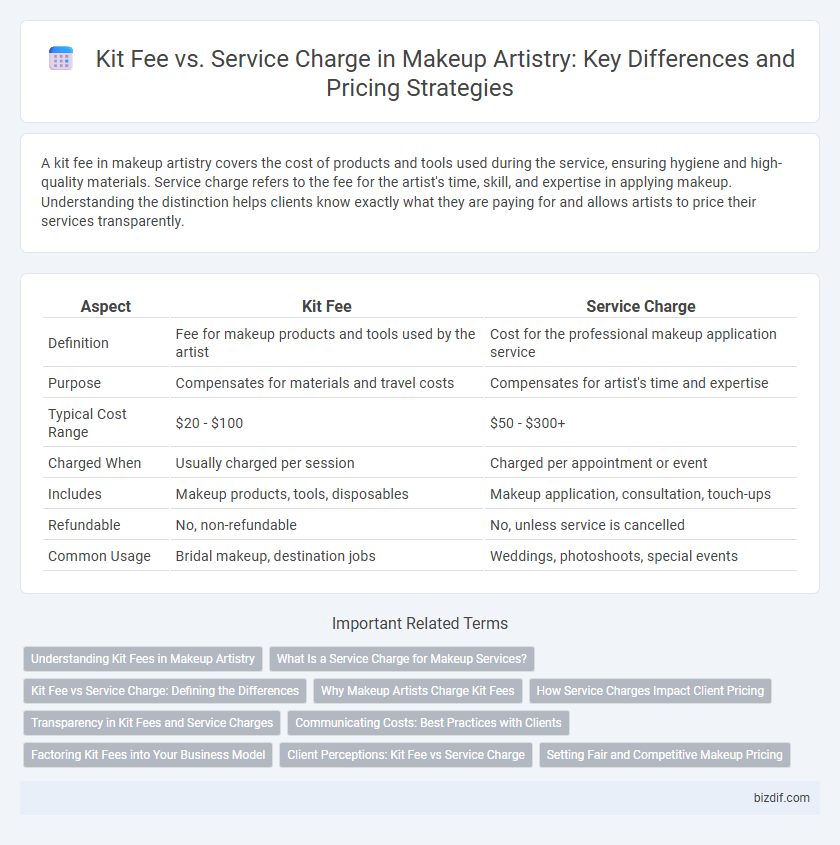A kit fee in makeup artistry covers the cost of products and tools used during the service, ensuring hygiene and high-quality materials. Service charge refers to the fee for the artist's time, skill, and expertise in applying makeup. Understanding the distinction helps clients know exactly what they are paying for and allows artists to price their services transparently.
Table of Comparison
| Aspect | Kit Fee | Service Charge |
|---|---|---|
| Definition | Fee for makeup products and tools used by the artist | Cost for the professional makeup application service |
| Purpose | Compensates for materials and travel costs | Compensates for artist's time and expertise |
| Typical Cost Range | $20 - $100 | $50 - $300+ |
| Charged When | Usually charged per session | Charged per appointment or event |
| Includes | Makeup products, tools, disposables | Makeup application, consultation, touch-ups |
| Refundable | No, non-refundable | No, unless service is cancelled |
| Common Usage | Bridal makeup, destination jobs | Weddings, photoshoots, special events |
Understanding Kit Fees in Makeup Artistry
Kit fees in makeup artistry cover the cost of professional-grade products and tools a makeup artist brings to ensure high-quality application and hygiene standards. These fees are separate from service charges, which compensate the artist for their time, skill, and creative expertise during the makeup session. Understanding the distinction between kit fees and service charges helps clients anticipate the total cost and appreciate the value of premium products used in their personalized makeup experience.
What Is a Service Charge for Makeup Services?
A service charge for makeup services is a fee imposed by makeup artists to cover their expertise, time, and personalized attention during the appointment. It differs from a kit fee, which covers the cost of the professional-grade products and tools used. Service charges typically reflect the artist's skill level and the complexity of the makeup application rather than just the materials provided.
Kit Fee vs Service Charge: Defining the Differences
Kit fee refers to the cost charged by makeup artists to cover the use and wear of their personal makeup products and tools during a service, ensuring hygiene and quality. Service charge, on the other hand, represents the fee for the artist's time, skill, and labor provided during the makeup application. Understanding the distinction helps clients recognize that kit fees support product expenses while service charges compensate professional expertise and execution.
Why Makeup Artists Charge Kit Fees
Makeup artists charge kit fees to cover the cost of high-quality products, tools, and hygiene supplies essential for each client's unique look and safety. This fee ensures artists can maintain a professional, sanitary kit stocked with a wide range of shades and brands to accommodate diverse skin tones and preferences. Charging a kit fee also protects artists from financial loss when clients do not show up or cancel last minute.
How Service Charges Impact Client Pricing
Service charges directly influence client pricing by adding a fixed or percentage-based cost to makeup artistry services, often covering overheads such as sanitation, travel, or setup time. Unlike kit fees that compensate for the makeup artist's personal product investments, service charges reflect operational expenses and ensure fair compensation for time and labor beyond application. Understanding how service charges affect final client costs helps maintain transparency and manage client expectations effectively.
Transparency in Kit Fees and Service Charges
Clear communication about kit fees and service charges is essential for maintaining transparency in makeup artistry, allowing clients to understand exactly what they are paying for. Kit fees typically cover the cost of professional-quality products and tools used during the service, while service charges relate to the artist's time and expertise. Transparent disclosure of these fees upfront builds trust and sets proper expectations, enhancing client satisfaction and professionalism in the beauty industry.
Communicating Costs: Best Practices with Clients
Clear communication of kit fees and service charges enhances client trust and sets transparent expectations for makeup artistry services. Detailed breakdowns of costs in contracts or consultations prevent misunderstandings and foster professional credibility. Highlighting the value of quality products and skilled application justifies fees, ensuring clients recognize the investment in their appearance.
Factoring Kit Fees into Your Business Model
Factoring kit fees into your makeup artistry business model ensures transparent pricing and proper compensation for the cost of professional-quality products used during appointments. Kit fees cover the expense of maintaining a diverse and sanitized collection of cosmetics and tools, reflecting the artist's investment and expertise. Clearly communicating kit fees alongside service charges helps manage client expectations and supports sustainable business growth.
Client Perceptions: Kit Fee vs Service Charge
Clients often perceive kit fees as transparent charges covering the makeup artist's products and tools, which can build trust by highlighting professionalism and investment in quality materials. Service charges tend to be viewed as broader fees encompassing the artist's expertise, time, and the overall experience, potentially influencing clients' expectations of value and service level. Understanding these distinctions helps makeup artists communicate costs clearly, shaping positive client perceptions and satisfaction.
Setting Fair and Competitive Makeup Pricing
Setting fair and competitive makeup pricing involves understanding the distinction between kit fees and service charges to reflect the true cost of artistry. Kit fees cover the investment in high-quality products and tools required for each client, while service charges account for the artist's skill, time, and personalized application technique. Balancing these fees ensures transparency, encourages client trust, and helps makeup artists maintain sustainable and competitive rates in the beauty industry.
Kit fee vs Service charge Infographic

 bizdif.com
bizdif.com